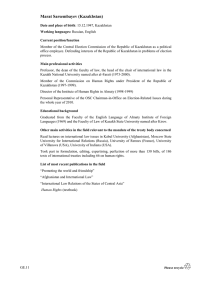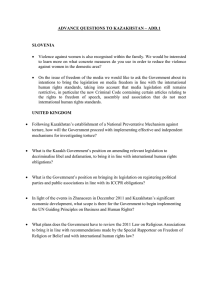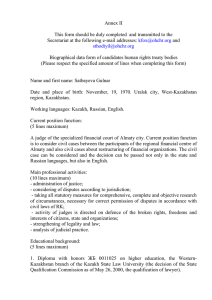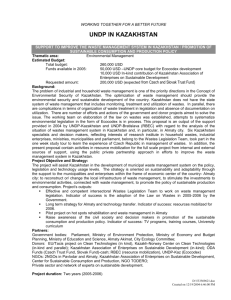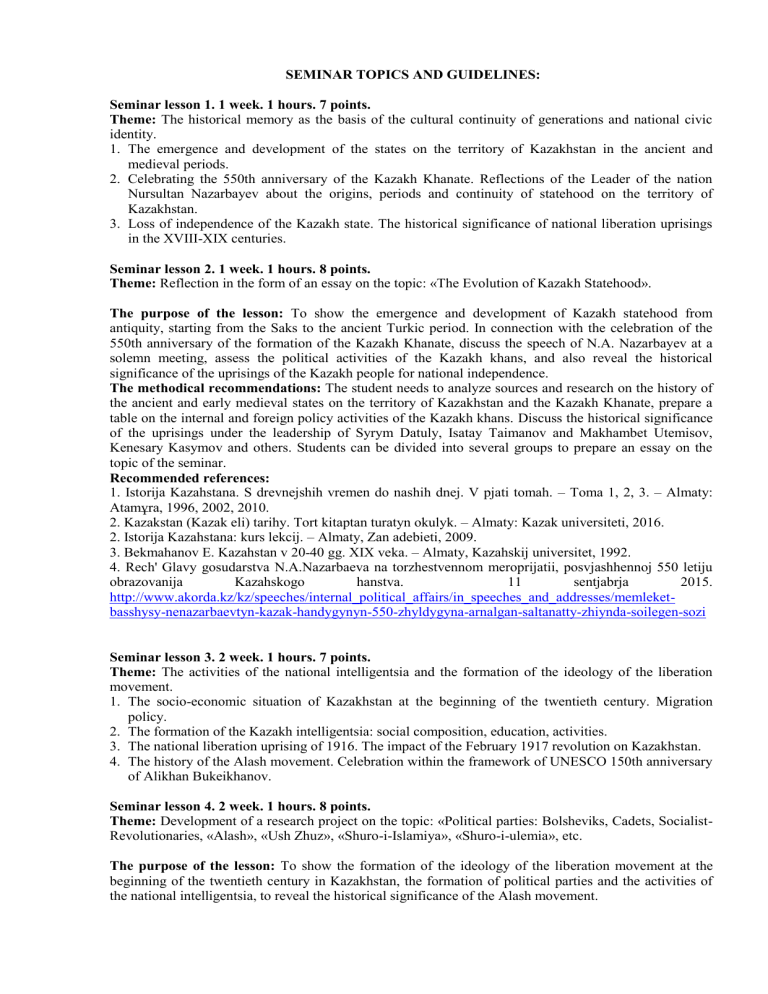
SEMINAR TOPICS AND GUIDELINES: Seminar lesson 1. 1 week. 1 hours. 7 points. Theme: The historical memory as the basis of the cultural continuity of generations and national civic identity. 1. The emergence and development of the states on the territory of Kazakhstan in the ancient and medieval periods. 2. Celebrating the 550th anniversary of the Kazakh Khanate. Reflections of the Leader of the nation Nursultan Nazarbayev about the origins, periods and continuity of statehood on the territory of Kazakhstan. 3. Loss of independence of the Kazakh state. The historical significance of national liberation uprisings in the XVIII-XIX centuries. Seminar lesson 2. 1 week. 1 hours. 8 points. Theme: Reflection in the form of an essay on the topic: «The Evolution of Kazakh Statehood». The purpose of the lesson: To show the emergence and development of Kazakh statehood from antiquity, starting from the Saks to the ancient Turkic period. In connection with the celebration of the 550th anniversary of the formation of the Kazakh Khanate, discuss the speech of N.A. Nazarbayev at a solemn meeting, assess the political activities of the Kazakh khans, and also reveal the historical significance of the uprisings of the Kazakh people for national independence. The methodical recommendations: The student needs to analyze sources and research on the history of the ancient and early medieval states on the territory of Kazakhstan and the Kazakh Khanate, prepare a table on the internal and foreign policy activities of the Kazakh khans. Discuss the historical significance of the uprisings under the leadership of Syrym Datuly, Isatay Taimanov and Makhambet Utemisov, Kenesary Kasymov and others. Students can be divided into several groups to prepare an essay on the topic of the seminar. Recommended references: 1. Istorija Kazahstana. S drevnejshih vremen do nashih dnej. V pjati tomah. – Toma 1, 2, 3. – Almaty: Atamұra, 1996, 2002, 2010. 2. Kazakstan (Kazak elі) tarihy. Tort kіtaptan turatyn okulyk. – Almaty: Kazak universitetі, 2016. 2. Istorija Kazahstana: kurs lekcij. – Almaty, Zan adebietі, 2009. 3. Bekmahanov E. Kazahstan v 20-40 gg. XIX veka. – Almaty, Kazahskij universitet, 1992. 4. Rech' Glavy gosudarstva N.A.Nazarbaeva na torzhestvennom meroprijatii, posvjashhennoj 550 letiju obrazovanija Kazahskogo hanstva. 11 sentjabrja 2015. http://www.akorda.kz/kz/speeches/internal_political_affairs/in_speeches_and_addresses/memleketbasshysy-nenazarbaevtyn-kazak-handygynyn-550-zhyldygyna-arnalgan-saltanatty-zhiynda-soilegen-sozi Seminar lesson 3. 2 week. 1 hours. 7 points. Theme: The activities of the national intelligentsia and the formation of the ideology of the liberation movement. 1. The socio-economic situation of Kazakhstan at the beginning of the twentieth century. Migration policy. 2. The formation of the Kazakh intelligentsia: social composition, education, activities. 3. The national liberation uprising of 1916. The impact of the February 1917 revolution on Kazakhstan. 4. The history of the Alash movement. Celebration within the framework of UNESCO 150th anniversary of Alikhan Bukeikhanov. Seminar lesson 4. 2 week. 1 hours. 8 points. Theme: Development of a research project on the topic: «Political parties: Bolsheviks, Cadets, SocialistRevolutionaries, «Alash», «Ush Zhuz», «Shuro-i-Islamiya», «Shuro-i-ulemia», etc. The purpose of the lesson: To show the formation of the ideology of the liberation movement at the beginning of the twentieth century in Kazakhstan, the formation of political parties and the activities of the national intelligentsia, to reveal the historical significance of the Alash movement. The methodical recommendations: Students should prepare for an oral survey on the socio-economic development of Kazakhstan at the beginning of the twentieth century, resettlement policy. To compile a table on the formation of the Kazakh intelligentsia. To reveal the essence and historical significance, as well as analyze documents and scientific works dedicated to the 100th anniversary of the national liberation uprising of 1916. Work with the map on the centers of the uprising. Students should study and determine the historical significance of the latest scientific literature on the history of Alash and the celebration within the framework of UNESCO of the 150th anniversary of the political leader of the Kazakh people Alikhan Bukeikhanov. Students should develop an educational research project on political parties formed at the beginning of the twentieth century. Recommended references: 1. Қojgeldiev M. Alash kozgalysy. – Almaty, 1995. 2. Alash kozgalysy. Dvizhenie Alash. /Kuzhattar men materialdar zhinagy/. t.1-4. - Almaty, 2004, 2005, 2010. 3. Nurpejіsov K. Alash һәm Alashorda. – Almaty, 1995. 4. Kazak ult-azattyk kozgalysy. ІІ kіtap. – Almaty, 2016. 5. Amanzholova D. Dvizhenie Alash v 1917 godu. - M., 1992. 6. Kazakstannyn kazіrgі zaman tarihy. Hrestomatija. (1917-1939). 1 t. - Almaty: Kazak universitetі, 2007. 7.Istorija Kazahstana.5 tomnik. 3-tom. – Almaty, Atamura, 2002. 8. Kazakstan (Kazak elі) tarihy. Tort kіtaptan turatyn oқulyk. – Almaty: Kazak universitetі, 2016. 9. Sovremennaja istorija Kazahstana.Uchebnik. – Almaty, Kazaқ universitetі, 2018. 10.Kazakstannyn kazіrgі zaman tarihy. Darіster kursy. – Almaty, Kazak universitetі: 2018. Seminar lesson 5-6. 3 week. 2 hours. 15 points. Theme: Specifics of the socio-economic and political modernization of Soviet power in Kazakhstan. 1. Command-administrative reforms in Kazakhstan and its consequences. 2. The policy of accelerated industrialization and theoretical discussions about the ways and forms of its implementation in Kazakhstan. 3. Kinks in the socialist restructuring of agriculture in Kazakhstan. 4. The politicization of socio-political life in the 20-30 years of the twentieth century. The purpose of the lesson: Analysis of socio-economic, political reforms of the command direction carried out by the Soviet government in the 20-30s of the twentieth century, subsequent changes in the policy of their implementation, the study of the results and the bitter consequences using historical facts. The methodical recommendations: a) The student, using sources and research, reveals the essence of the policy of "war communism", the land-water reform of 1921-1922, the ideas of "Small October" and their command and administrative direction; b) analysis of the positions of the Kazakh intelligentsia on the issue of industrialization based on their works, analysis of theoretical discussions; c) redistribution of grassland and pasture lands and its results, confiscation of Bai farms, forced collectivization and other transformations of Soviet power; d) the student must use documents and materials to disclose the essence of the "Great Terror", its scope and dire consequences. Recommended references: 1. Masanov N.Je “Kochevaja civilizacija kazahov”. – Almaty: “Akademija nauk RK. Institut istorii,arheologii i jetnografii im.Ch.Ch Valihanova”.1995. 2. Kollektivizacija sel'skogo hozjajstva Kazahstana. Ch. 1. – Almaty: “Central'nyj gos. Arhiv KazSSR.Institut istorii,arheologii i jetnografii AN KazSSR/pod red.A.B Tursunbaeva”, 1967. 3. Istorija industrializacii Kazahskoj SSR(1926-1941gg.) dokumenty i materialy: v dvuh tomah.Akademija nauk KazSSR.Institut istorii,arheologii i jetnografii im Ch.Ch.Valihanova. – Nauka KazSSR,1967. 4. Kozybaev M.K., Abylhozhin Zh.B., Aldazhumanov K.S. Kollektivizacija v Kazahstane: tragedija krest'janstva.-Almaty:Akademija nauk RK,Ministerstvo narodnogo obrazovanija RK,Institut istorii i jetnologii im.Ch.Valihanova,1992. 5. Ivnickij N.A. Kollektivizacija i raskulachivanie.-M. :Nauchnyj jekspert,1994.-312s 6. Aldazhumanov K.S: “Otkrytye sudebnye processy” 1937g.v Kazahstane.Materialy “kruglyh stolov” i seminarov.–Almaty: Akademija nauk RK. Institut istorii, arheologii i jetnografii im.Ch.Ch.Valihanova,1996. 7. Azaly kіtap-Kniga skorbi,Rasstrel'nye spiski.Vypusk 1. – Almaty: Zerde,1998. 8. Kazakstan tarihy (kone zamannan bugіnge dejіn). Bes tomdyk 5-tom.-Almaty: “Atamura” , 2010 9. Kazakstan (Kazak elі) tarihy. Tort kіtaptan turatyn okulyk. – Almaty: Kazak universitetі, 2016. Seminar lesson 7. 4 week. 1 hours. 7 points. Theme: The consequences of the forcible destruction of the traditional economy of the Kazakhs. 1. The famine in Kazakhstan 1930-33-ies .: modern research and new directions in the study of the issue. 2. The mass migration of the population. 3. The people's protests and uprisings against the dispossession and forced collectivization. Seminar lesson 8. 4 week. 1 hours. 8 points. Theme: Development of a research project on the topic: «Contradictions of the Soviet government reforms in education: the transition of the Kazakh language from Arabic alphabet to Cyrillic and opposition to reforms led by A. Baitursynov». The purpose of the lesson: To reveal the essence of Soviet collectivization, the policy of subsidence, the liquidation of private property. Show the effects of the demographic crisis, mass migration in Kazakhstan. The methodical recommendations: Students should analyze the views of domestic and foreign researchers about the problem posed. In addition, according to published archival documents, it is necessary to make a statistical content that reflects the nature of famine, resettlement outside the country, and uprisings. It is necessary to discuss literary works, feature films related to this topic from the point of view of human fate. Recommended references: 1. Abylhozhin Zh. Ocherki social'no-jekonomicheskoj istorii Kazahstana. XX vek. — Almaty, 1998. 2. Omarbekov T. Golodomor v Kazahstane (hrestomatija). – Almaty, Kazak universitetі., 2011. 3. Omarbekov T. 1929-1931 zhyldardagy halyk koterіlіsterі. Almaty: «Arys», 2018. 4. Marta Brill Olkott. «Kollektivizacija v Kazahstane», Rossijskij Obzor 40, nom. 2 (1981 g.): 122-142. 5. Sara Kameron, «Golodnye stepi: sovetskij Kazahstan i kazahskij golod, 1921-1934 gg,» (doktorskaja diss., Universitet Jjelja, 2010 g.); Golod kazahov po dannym Zapadnoj istoriografii. Istochnik: https://ehistory.kz/ru/contents/view/1432 6. Nikkolo Pianchiola «Golod v stepi: kollektivizacija sel'skogo hozjajstva i kazahskih skotovodov, 1928-1934 gg.» CahiersduMonderusse 45 nom. 1-2(2004 g.):137-192. Seminar lesson 9. 5 week. 1 hours. 7 points. Theme: Political and socio-economic crisis of Soviet society. 1. The apogee of the "cult of personality." Political processes of the 40-50s. 2. Reforms of N. Khrushchev (1956-1964) (positive changes in education and science; liberalization and revitalization of social and political life; positive progress in the sphere of welfare of the population). 3. The growing crisis of the Soviet socio-political system (1964-1985). 4. The economy of Kazakhstan in the 70-80s, the reasons for the insensitiveness to scientific and technological progress. 5. Stagnation of the level and quality of life of the population and environmental problems. Seminar lesson 10. 5 week. 1 hours. 8 points. Theme: Development of a research project on the topic: «Strengthening of party control in public life aimed at limiting human rights: accusing professional historian E.B. Bekmakhanov of «biased» study of the history of Kenesary Kasymov's uprising». The purpose of the lesson: provide the necessary amount of knowledge, scientifically reliable facts about the content of the main events of the history of Soviet Kazakhstan in the post-war period and before the start of the "Gorbachev`s perestroika" from modern conceptual positions and without emotional layering. The methodical recommendations: It is important to determine the essence of the Soviet socialist system and its features in Kazakhstan; to pay attention to the influence of ideological dogmas and stereotypes on the development of science and education; to find out the essence of extensive economic development in a crisis of the command-administrative system. Recommended references: 1.Istorija Kazahstana. V 5-ti tomah. T.5. – Almaty: Atamura, 2010. 2.Altaev A.Sh., Zhanguttin B.O. Istorija Kazahstana: Hrestomatija. T.2. – Almaty: Bastau. 2008. 3. Kunaev D.A. Ot Stalina do Gorbachjova. - Almaty: Sanat, 1994. 4.Nazarbaev N. Bez pravyh i levyh. M., 1991. 5. Kozybaev M.K. Kazahstan i sovremennost'. A., 1991. 6.Kunaev D.A. O moem vremeni. - A., 1992. 7.Kunaev D.A. Ot Stalina do Gorbacheva. A., 1994. 8.Saktaganova Z.G. Istorija osushhestvlenija Sovetskogo opyta jekonomicheskoj modernizacii v Kazahstane. 1946-1970 gg. Karaganda 2004. Seminar lesson 11. 6 week. 1 hours. 5 points. Theme: The growth of centrifugal forces and the national identity in Kazakhstan. 1. April Plenum of the Central Committee of the CPSU in 1985. The course towards "perestroika". 2. Attempts to carry out reforms in the field of economics and their consequences. 3. The socio-political life of Kazakhstani society and the beginning of the formation of the constitutional state. Seminar lesson 12. 6 week. 1 hours. 5 points. Theme: Reflection in the form of an essay on the topic: «The process of personality transformation under the influence of historical reality». The purpose of the lesson: reveal the contents of which took place in the years of "perestroika" of changes in the life of Kazakhstani society, and show the effects of the systemic crisis, which led to the growth of national consciousness and the creation of a democratic constitutional state. The methodical recommendations: In preparation for the questions, it is necessary to carefully study the documentary base of the indicated topic of the seminar (materials of the April 1985 Plenum of the CPSU Central Committee, the XXVII Congress of the CPSU (1986), the January 1987 Plenum of the CPSU Central Committee, the Resolution of the CPSU Central Committee "On measures to overcome drunkenness and alcoholism" (1985), the Law on the State Enterprise of 1987, Materials of the Commission for the Investigation of the December Events of 1986 in Kazakhstan, the Law of the Kazakh SSR on Languages of 1989, etc.). In the study of the first and second questions, special attention should be paid to the disclosure of the meaning of the concepts “course towards accelerating the country's socioeconomic development”, “perestroika”, and “publicity”. This will make it possible to understand the causes and inconsistency of methods for carrying out socio-economic reforms. The third question is an extensive field for studying the consequences of the political crisis of Soviet society, which led to an increase in national identity, which was reflected in Kazakhstan in 1986 and the measures that led to changes in the field of national politics. Recommended references: 1.Istorija Kazahstana. V 5-ti tomah. T.5. – Almaty: Atamura, 2010. 2.Altaev A.Sh., Zhanguttin B.O. Istorija Kazahstana: Hrestomatija. T.2. – Almaty: Bastau. 2008. 3. Kunaev D.A. Ot Stalina do Gorbachjova. - Almaty: Sanat, 1994. 4.Nazarbaev N. Bez pravyh i levyh. M., 1991. 5.Kydyralina Zh.U. Nacija i istorija.- Astana: Elorda, 2009. Seminar lesson 13-14. 7 week. 2 hours. 10 points. Theme: National Revival of Kazakhstan and the establishment of a democratic constitutional state. 1. The independence as a factor of national and state building. Determination of the state development strategy of independent Kazakhstan. 2. Modernization of public administration within the executive vertical. 3. Legal reform and humanization of laws. Optimization of the law enforcement system. The purpose of the lesson: To reveal the strategy of formation and development of Kazakhstan as a democratic state of law. The methodical recommendations: The student needs to study and evaluate the formation of the domestic and foreign policies of an independent state, as well as determine the state development strategy of independent Kazakhstan. To analyze the strengthening of national security and the development of state identity. Students can be divided into several groups to prepare a presentation message on the topic of the seminar. Recommended references: 1. Kazakstan Respublikasynyn Konstitucijasy. – Almaty, 1995. Ajagan B.Ғ., Abzhanov H.M., Mahat D.A. Kazіrgі Kazakstan tarihy. – Almaty, 2010. Nazarbaev N.A. Strategija nezavisimosti. –, 2003. Nazarbaev N.A. Kazakstan zholy. – Astana, Almaty 2007. Nazarbaev N.A. Tauelsіzdіk belesterі. – Almaty, 2003. Nazarbaev N.A. Strategija stanovlenija i razvitija Kazahstana kak suverennogo gosudarstva.- Almaty, 1992. 7. Kazakstan (Kazak elі) tarihy. – 4 kіtaptan turatyn okulyk. Tauelsіz Kazakstan: algysharttary zhane kalyptasuy. 4 kіtap. – Almaty, Kazak universitetі, 2016. 8. Nazarbaev N.A. V potoke istorii. – Almaty, 1999. 2. 3. 4. 5. 6. Seminar lesson 15. 8 week. 1 hours. 5 points. Theme: Stages of modernization and specificity of the economic reforms of the Republic of Kazakhstan. Development of a program or plan on the topic: «The cluster principle of economic development improving the competitiveness of the country». 1. The global economic crisis and measures to successfully overcome it. 2. The development of the economy and the financial sector in the post-crisis period. 3. The Kazakhstan model of the economy in the twenty-first century. 4. Importance for Kazakhstan of the EXPO-2017. Seminar lesson 16. 8 week. 1 hours. 5 points. Theme: Development of a program or plan on the topic: «The cluster principle of economic development - improving the competitiveness of the country». The purpose of the lesson: filling with real scientific and historical knowledge of the content of the Kazakhstan model of economic development during the period of accelerated modernization and the republic's exit in the direction of economic self-sufficiency. The methodical recommendations: get acquainted with the recommended literature and government programs. Also, analyze the opinions and assessments of international experts on economic development. Recommended references: 1. Kazakstan tarihy. 5 tomdyk. 5-tom. – Almaty, 2010. 2. Kazakstan (Kazak elі) tarihy. – 4 kіtaptan turatyn okulyk. Tauelsіz Kazakstan: algysharttary zhane kalyptasuy. 4 kіtap. – Almaty, Kazak universitetі, 2016. 3. Nazarbaev N.A. "Kazakstan - 2050" strategijasy – kalyptaskan memlekettіn zhana sajasi bagyty". KR Prezidentі-Elbasy N.A.Nazarbaevtyn Kazakstan halkyna Zholdauy. 14 zheltoksan 2014 zh. http://www.akorda.kz 4. Nazarbaev N.A. Strategija nezavisimosti. – Almaty, 2003. 5. Sovremennyj Kazahstan: strategija uspeha/ pod red. M.E.Shajhutdinova . – Almaty, 2008. Seminar lesson 17-18. 9 week. 2 hours. 10 points. Theme: Social reforms and their results that led to qualitative changes in the Kazakhstani society. 1. Social problems and their solutions in the early years of independence. 2. Priority areas of social modernization of Kazakhstan. 3. State programs on the way of reforming the social sphere. The purpose of the lesson: Show the ways of forming an effective model of social development of the Republic of Kazakhstan. Reveal the mechanisms for implementing social reforms that led to qualitative changes in society, preserving domestic political stability and national harmony. The methodical recommendations: Students need to identify the causes of tension in the social sphere. Describe the "idea of a socially-oriented economy." To prepare reports on State programs defining the strategic goals of social development. Recommended references: 1. Istorija Kazahstana. V 5-ti tomah.4- 5-j tom. Almaty: Atamұra, 2010. 2. Istorija nezavisimogo Kazahstana - Almaty: «Kazak jenciklopedijasy», 2011. 3. Strategija "Kazahstan-2050":novyj politicheskij kurs sostojavshegosja www.Strategy2050.kz. 4. Nazarbaev.N.A. Jera Nezavisimosti. Astana, 2017 gosudarstva. Seminar lesson 19. 10 week. 1 hours. 5 points. Theme: Importance and ways of strengthening interethnic harmony in the Republic of Kazakhstan. Content analysis: «Ethnodemographic changes in Kazakhstan based on census materials». 1. The formation of Kazakhstani identity on the basis of national-historical, socio-psychological, political and cultural features. 2. Interethnic harmony is the basis for strengthening independence and democracy in the Republic of Kazakhstan. 3. Creation of the Assembly of the Nations of Kazakhstan (ANK) Seminar lesson 20. 10 week. 1 hours. 5 points. Theme: Content analysis: «Ethnodemographic changes in Kazakhstan based on census materials». The purpose of the lesson: analyze the features and significance of the modern Kazakhstan development model. The methodical recommendations: to get acquainted with the recommended literature, give an objective assessment of ethno-demographic processes based on the analysis of data from statistical agencies. Recommended references: 1. Strategija "Kazahstan-2050": novyj politicheskij kurs sostojavshegosja gosudarstva. 14 dekabrja 2012 g. //www.Strategy2050.kz. 2. Mendikulova G.M. Kazahskaja diaspora: istorija i sovremennost'. –Almaty, 2006. 3. Tәuelsіz Kazakstan tarihy: Hrestomatija. Almaty: Kazak universitetі, 2013. Seminar lesson 21. 11 week. 1 hours. 7 points. Theme: A new system of values, features and originality of Kazakhstani society. Development of a program or plan on the topic: «State programs - the basis for the development of Kazakhstan». 1. Political parties and social movements in the Republic of Kazakhstan. 2. Youth policy in the Republic of Kazakhstan and the spiritual path of modernization. "Kazakhstan2020" Development Program. 3. Legislative support of religious freedom and interfaith harmony in Kazakhstan. 4. Congresses of leaders of world and traditional religions in Astana Seminar lesson 22. 11 week. 1 hours. 8 points. Theme: Development of a program or plan on the topic: «State programs - the basis for the development of Kazakhstan». The purpose of the lesson: To reveal the significance of the new system of public values, the features and originality of the Republic of Kazakhstan on the path to democratization. The methodical recommendations: Students should familiarize themselves with the text of the Strategy “Kazakhstan - 2050”. To prepare reports on the following blocks: development of civil society and its sociopolitical institutions; forum of the nations of Kazakhstan, social movements and parties of the Republic of Kazakhstan; Law about political parties of the Republic of Kazakhstan and its significance. To analyze the political doctrine "On the path to a brighter future" - "Nurly Bolashak Zholynda." Students should also reveal the importance of youth policy in the Republic of Kazakhstan. To show the possibilities of Kazakhstani youth in the implementation of the tasks. To determine the importance of the formation of historical consciousness among young people. To analyze the issues considered at the congresses of leaders of world and traditional religions (I III). Recommended references: 1. Istorija Kazahstana. V 5 t. 5-tom. – Almaty, 2010. 2. Istorija Kazahstana. Kurs lekcij. – Almaty, 2009. 3. Ajagan B.Ғ., Abzhanov H.M., Mahat D.A. Sovremennaja istorija Kazahstana. – Almaty, 2010. 4. Nazarbaev N.A. Strategija «Kazahstan-2050» Novyj politicheskij kurs sostojavshegosja gosudarstva 15 dekabrja 2012 zh. http://www.akorda.kz 5. Kazakstan Respublikasy zhastar sajasatynyn «Kazakstan 2020: bolashaққa zhol» atty tuzhyrymdamasy. https://www.google.com/search. 6. Sajlan B.S.Kenestіk bilіktegі Kazakstannyn zhastar sajasaty: tarihy men tagylymy (1917-1991). – Almaty: KazMemKyzPU, 2011. Seminar lesson 23. 12 week. 1 hours. 7 points. Theme: Preservation of historical memory, as the basis of self-identity and development of Kazakhstani identity. 1. The study of ancient Turkic writing and Turkic monuments of culture in the years of independence (Proceedings of Abu Nasr al-Farabi, Zh.Balasaguni, M.Kashgari, H.A.Yassaui). 2. The study of the oral heritage (historical tradition) of the Kazakh people and written historiography (works of Muhammad Haidar Dulati, Kadyrgali Kasym-uly Jalairi) in modern conditions. 3. The spiritual heritage of Kazakh figures of the nineteenth and twentieth centuries. Seminar lesson 24. 12 week. 1 hours. 8 points. Theme: Essay: "The study of the oral heritage (historic tradition) of the Kazakh people and written historiography (the works of Muhammad Haydar Dulati, Kadyrgali Kassym-uly Zhalairi) in modern conditions." The purpose of the lesson: analyze the importance of historical memory, as well as its role in the development of Kazakhstani identity. The methodical recommendations: The student needs to make a table on the monuments of Turkic culture and evaluate the study of the works of medieval thinkers in the years of independence. Remember the rich spiritual heritage of the Kazakh known personalities of the XIX-XX centuries. Recommended references: 1.Kazakstan tarihy. 5 tomdyk. 4,5 tt. Almaty: Atamura, 2010. 2. Al'-Farabi i duhovnoe nasledie=әl-Farabi zhane ruhani mura/ [Redkol.: K. Naribaev, A. Derbisaliev i dr.].- Almaty: Kajnar, 1994. 3.Kasymzhanova A.A. Al'-Farabi i arabo-musul'manskaja kul'tura.- Almaty: 2001. 4.Nasledie al'-Farabi i mirovaja kul'tura: materialy mezhdunar. kongressa / M-vo obrazovanija i nauki RK, In-t filosofii i politologii; [gl. red. A. N. Nysanbaev].- Almaty: 2001. 5.https://www.kazportal.kz/razvitie-farabievedeniya-v-kazahstane 6. Nazarbaev N.A. V potoke istorii. – Almaty, 1999. 7. https://articlekz.com/kk/article/16361 8. https://e-history.kz/ru/publications/view/1418 9.https://helpiks.org/9-16389.html 10.https://e-history.kz/ru/publications/view/2606 Seminar lesson 25-26. 13 week. 2 hours. 15 points. Theme: Activities of the Republic of Kazakhstan on solving global and regional problems. 1. Active participation of the Republic of Kazakhstan in the development of international safety guidelines. 2. Membership of Kazakhstan in the UN Security Council, Kazakhstan and the UN: cooperation for peace, security and development. 3. The role of Kazakhstan in ensuring regional security in Central Asia. CSTO: ensuring the national security of Kazakhstan through instruments of collective cooperation. The purpose of the lesson: to reveal the activities of the Republic of Kazakhstan in solving global and regional problems. The methodical recommendations: Based on the proposed literature and sources, study the foreign policy initiatives of the Republic of Kazakhstan on regional security in Central Asia, the role and initiatives of Kazakhstan in resolving regional conflicts and threats, Kazakhstan’s participation in international organizations to ensure stability and security in the modern world. Recommended references: 1. Vneshnepoliticheskie iniciativy Prezidenta Respubliki Kazahstan N.A. Nazarbaeva. Istorikodokumental'noe issledovanie / G. Nurymbetova, R. Kudajbergenov. - Almaty, 2010. 2. Torkunov A.V. Jenergeticheskie izmerenija mezhdunarodnyh otnoshenij v Vostochnoj Azii // Po doroge v budushhee. - M., 2010. 3. Laumulin M. T. Central'naja Azija v zarubezhnoj politologii i mirovoj geopolitike. Tom III. Geopolitika i mezhdunarodnye otnoshenija (vtoraja polovina XX - nachalo XXI vv.).- Almaty, 2009. 4. Tukumov E.V. Vneshnjaja politika Kazahstana za gody nezavisimosti: itogi, rezul'taty, dostizhenija// nomad.su/?a=3-201112150027 5. Tokaev K.-Zh. K. Preodolenie: Diplomaticheskie ocherki kazahstanskogo ministra. — M.: Mir, 2003. 6. Diplomaticheskaja sluzhba Respubliki Kazahstan: uchebnoe posobie / pod obshh. red. K. K. Tokaeva. — Almaty: Jedel'vejs, 2004. 7. Tokaev K.-Zh. K. Svet i ten': ocherki kazahstanskogo politika. — M.: Vostok-Zapad, 2008. Sources: Istochniki: Deklaracija o sovershenstvovanii sotrudnichestva mezhdu OON i regional'nymi soglashenijami ili organami v oblasti podderzhanija mezhdunarodnogo mira i bezopasnosti (1994 g.). Deklaracija ob ustanovlenii faktov Organizaciej Ob#edinennyh Nacij v oblasti podderzhanija mezhdunarodnogo mira i bezopasnosti (1991 g.). Deklaracija o predotvrashhenii i ustranenii sporov i situacij, kotorye mogut ugrozhat' mezhdu­narodnomu miru i bezopasnosti, i o roli Organizacii Ob#edinennyh Nacij v jetoj oblasti (1988 g.). Deklaracija ob usilenii jeffektivnosti principa otkaza ot ugrozy siloj ili ee primenenija v mezhdunarodnyh otnoshenijah (1987 g.). Manil'skaja deklaracija o mirnom razreshenii mezhdunarodnyh sporov (1982 g.). Deklaracija ob ukreplenii mezhdunarodnoj bezopasnosti (1970 g.). Koncepcija vneshnej politiki RK na 2014-2020 gg.Utverzhdena Ukazom Prezidenta Respubliki Kazahstan ot 21 janvarja 2014 goda № 741.//http://mfa.gov.kz/kz/content-view/kontseptsiya-vneshnojpolitiki-rk-na-2014-2020-gg Seminar lesson 27. 14 week. 1 hours. 7 points. Theme: The contribution of the First President to the theory and practice of public administration. Reflection in the form of an essay on the topic: «The past, present and future of mankind in the writings of the Leader of the Nation N.A. Nazarbayev». 1. The stages of the construction of a sovereign state, the principles of the mechanism and the driving forces of development, three waves of modernization aimed at updating the country and advancement into thirty prosperous states, in the work "Era of Independence". 2. Modern Kazakhstan - the heir to the Great Transformed Steppe - Uly Dala Elі. The basis of creation of Kazakhstan's model of statehood. 3. The problems of terrorism, regional security and measures to combat them in the work "Critical Decade". Seminar lesson 28. 14 week. 1 hours. 8 points. Theme: Reflection in the form of an essay on the topic: «The past, present and future of mankind in the writings of the Leader of the Nation N.A. Nazarbayev». The purpose of the lesson: To analyze the activities and the indicated works of the leader of the nation N.A. Nazarbayev, historical events to preserve international security in achieving the idea of "Mangilik El." The methodical recommendations: Students should analyze historical events, stages of development of Kazakhstan, plans for joining 30 developed countries, ways to achieve the idea of "Mangilik El", discuss the book "Era of Independence". Also, familiarize yourself with the text of the Patriotic Act and prove that the idea of "Mangilik El" is important not only for the past of the country, but primarily for the future. Identify the importance of forming an idea leading to a common goal. These identified important issues should be deeply and comprehensively addressed in the discussion. Recommended references: 1. Poslanie prezidenta Respubliki Kazahstan - lidera nacii N. A. Nazarbaeva narodu Kazahstana «Strategija «Kazahstan-2050» ot 14 dekabrja 2012 g. http://www.akorda.kz 2. Poslanie prezidenta Respubliki Kazahstan - lidera nacii N. A. Nazarbaeva narodu Kazahstana «Kazahstanskij put' – 2050: Edinaja cel', edinye interesy, edinoe budushhee» 17 janvarja 2014 g. http://www.akorda.kz 3. Poslanie Prezidenta Respubliki Kazahstan N.Nazarbaeva narodu Kazahstana. «Kazahstan v novoj global'noj real'nosti: rost, reformy, razvitie» 30 nojabrja 2015 g. http://www.akorda.kz 4. Nazarbaev N.A. Jera Nezavisimosti. - Almaty: ҚazAқparat, 2017. Seminar lesson 29. 15 week. 1 hours. 7 points. Theme: Nur-Sultan is a symbol of renewal of Kazakhstan, a symbol of the originative energy of its multinational people. 1. Nur-Sultan - a symbol of independence and new beginnings; 2. Nur-Sultan - the center of world cooperation and innovation; 3. The cultural and spiritual development of Nur-Sultan. Seminar lesson 30. 15 week. 1 hours. 8 points. Theme: Development of a project on the topic: «Implementation of the «Ruhani Zhangyru» program in the regions of the Republic of Kazakhstan». The purpose of the lesson: To show the cultural and political significance of Nur-Sultan not only in the republic but also on a global scale. The methodical recommendations: In preparation for the first question of the seminar, it is necessary to consider the history of the city: when the city was founded, what historical monuments exist in the region, the reasons for the transfer of the capital and what semantic loads are the architectural monuments of NurSultan. When studying the second question, you should familiarize yourself and analyze the outwardly political initiatives of the First President of the Republic of Kazakhstan N.A. Nazarbayev: the idea of the Eurasian Union, the Shanghai Cooperation Organization, the customs union, etc. Particular attention should be paid to what important international meetings and conferences were held in Nur-Sultan, to resolve which international problems, a platform was provided during the EXPO-2017. Think about the impact of these events on the international image of Kazakhstan. When preparing for the third question, it is necessary to show that the capital is not only the political and cultural center of the country. What achievements have been achieved in the field of art, culture and education in Nur-Sultan. What impulse to cultural construction in the republic was given by the adopted programs for the preservation of cultural heritage, history and spiritual modernization. Recommended references: 1. N.A.Nazarbaev «V serdce Evrazii». – Almaty, «Atamұra», 2008. 2. N.A.Nazarbaev «Strana v serdce Evrazii». – 2016. 3. N.A. Nazarbaev «Jera nezavisimosti». - Almaty: ҚazAқparat, 2017. 4. A.Dzhaksybekova "Tak nachinalas' Astana. Zapiski pervogo akima stolicy". – 2017. 5. Rustemov Bahyt "Astana - gordost' i simvol obnovlennogo Kazahstana". – Astana, 2008. 6. Absemetov M.O. "Astana - gorod s tysjacheletnej istoriej". – Astana, 2019. 7. G.V. Kan «Istorija Kazahstana. Uchebnik dlja VUZ-ov». – Almaty. 2013. 8. Astana. Enciklopediya. – Atamұra, 2008.
